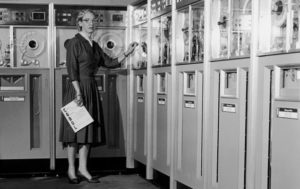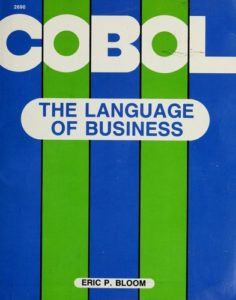The COBOL Programming Language
Created in 1959 as a universal programming language, but oriented towards the implementation of management software, COBOL (for COmmon Business-Oriented Language) was the result of a commission made up of computer manufacturers, users, and the US Department of Defense. Its development was strongly influenced by Grace Hopper’s previous work in a language whose syntax was close to spoken English (Flow-Matic).
Imperative, procedural language and strongly structured in four sections (identification, environment, data and procedure), COBOL was standardized for the first time in 1968 and allowed object-oriented programming since 2002. The involvement of the Department of Defense, which forces manufacturers to including it in the hardware distribution made it the language of choice for the creation in its day of the vast majority of management applications to run on large mainframe systems. However, among others, the fact that the University was left out of its development, or criticism of the formal definition of its syntax, makes the computer community not consider COBOL and prefer other languages such as Fortran.

Grace Hopper (1959) carrying a COBOL manual
Despite the original attempt to create a programming language close to natural language, COBOL‘s rigid syntax and structure, along with the language’s more than 300 reserved words, makes COBOL programs appear redundant and unreadable. The appearance of new general-purpose languages, powerful management applications, the disappearance of large mainframe systems, and the usual size of COBOL applications, means that COBOL programming is currently reduced to the maintenance of these large applications.
In 2006 and 2012, Computerworld magazine reported that 60% of companies used COBOL and that for half of them it was the primary language used in their management applications. The intention of migrating COBOL software depends for many of these companies on the cost involved, although sometimes they have changed large mainframes for more current and cheaper hardware but have kept COBOL applications. This trend may change due to the lack of expert programmers who can take care of the maintenance of existing applications (many US agencies expressed this lack during the COVID-19 pandemic).
In 2006 and 2012, Computerworld magazine reported that 60% of companies used COBOL and that for half of them it was the primary language used in their management applications. The intention of migrating COBOL software depends for many of these companies on the cost involved, although sometimes they have changed large mainframes for more current and cheaper hardware but have kept COBOL applications. This trend may change due to the lack of expert programmers who can take care of the maintenance of existing applications (many US agencies expressed this lack during the COVID-19 pandemic).
COBOL has influenced the definition of other languages such as Pascal, as well as the explicit structure of its data files influenced later database management systems. Even today (2021) it occupies the 29th position among the most popular programming languages according to the TIOBE ranking.
COBOL
Born:1960
Evolution: Cobol 61; ANSI Cobol 74; ANSI Cobol 85; Cobol 2002 (2002)
Influences of: FlowMatic
Influences: Pascal; DBase; SQL

